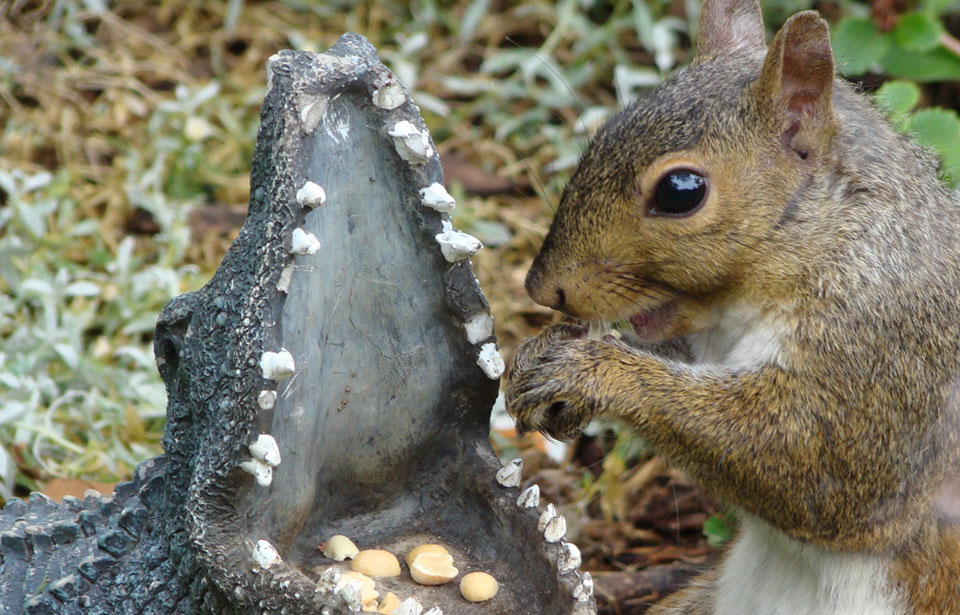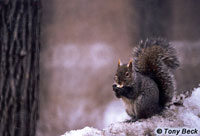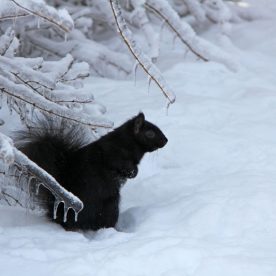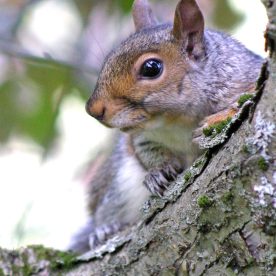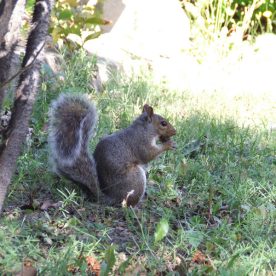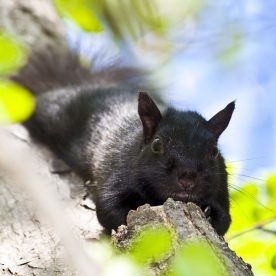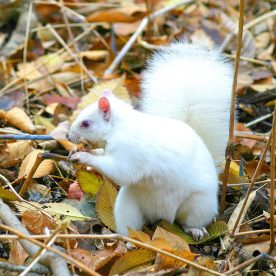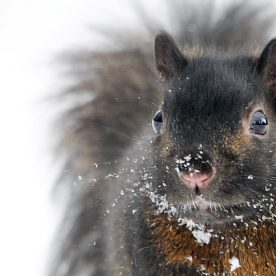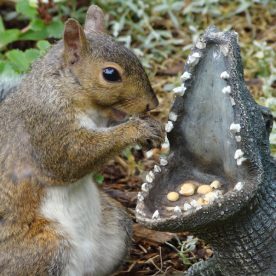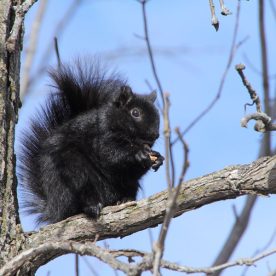Description
Eastern grey squirrels Sciurus carolinensis commonly occur in two colour phases, grey and black, which leads people to think—mistakenly—that there are two different species. Black is often the dominant colour in Ontario and Quebec, toward the northern limits of the species’ range. Farther south the black phase is less common and is not found at all in the southern United States. This may indicate that the gene responsible for black coloration has some cold-weather adaptation associated with it. Albino eastern grey squirrels also occur and in the United States a few small, completely white populations are found. There are rare instances of a reddish colour phase and some animals may also have a combination of colours, for example a black body with a red tail. These individuals should not be confused with the American red squirrel Tamiasciurus hudsonicus, which is common to Canada’s northern forests, nor with Douglas’s squirrel T. douglasii, found in British Columbia. Both of these are smaller animals with a rusty red colour on the body, head, and tail.
The squirrel’s fur is thicker and longer in winter. The fur colour is grey or black and may change with the seasons. The grey fur is a grizzled salt-and-pepper combination produced by lead-grey underfur, overlain by banded grey and black guard hairs tipped with white. Black individuals are generally a glossy uniform black all over, but the species may show all shades of gradation between black and grey. A litter may contain both black and grey individuals.
The most notable physical feature of the eastern grey squirrel is its large bushy tail. Indeed, the Latin word for squirrel, sciurus, is derived from two Greek words, skia, meaning shadow, and oura, meaning tail. Combining the two means loosely that the squirrel is one that sits in the shadow of its own tail. Many of the common names given to the eastern grey squirrel, such as Bannertail and Silvertail, call attention to this prominent feature.
The tail has many important functions. It acts as a rudder when the animal jumps from high places, as a warm covering during the winter, as a signal to other eastern grey squirrels indicating an individual’s mood, and perhaps as a sunshade. Finally, the tail can be used to distract a pursuing predator.
Signs and sounds
There are typical signs that eastern grey squirrels inhabit an area. The gnawed husks and shells of nuts, especially acorns, hickory nuts, walnuts, beechnuts, and pecans, can be found littering the ground around the base of a tree where the squirrels have been feeding. In winter small holes in the snow or ground indicate where squirrels have been digging to find hidden stores of nuts buried earlier in the year.
The tracks of eastern grey squirrels are distinctive: forefeet leave a round print about 2.5 cm long; the hindprints are more triangular, approximately 6 cm long. When the squirrel bounds across the ground the tracks are paired, hindprints slightly ahead of the foreprints. In the snow these tracks often look like two exclamation marks (!!). This bounding stride may be as much as 1 m if the animal is in a hurry.
The eastern grey squirrel’s alarm call is a series of rapid clicking sounds—kuk, kuk, kuk—which warns all other nearby squirrels of danger. Sometimes several squirrels join together to taunt a predator with a chorus of scolding accompanied by agitated twitches of the tail. In an aggressive encounter between two squirrels, tooth chattering is often heard. A more commonly heard vocalization is a rasping whisk accentuated by a flick of the tail.
A noticeable sign of the presence of the grey squirrel is the large leaf nest, or drey.
Habitat and Habits
The eastern grey squirrel is the largest tree squirrel found in eastern Canada. It is predominantly a nut-eating species and its historic range coincided with the vast tracts of hardwood forests in eastern North America, in particular with oak and hickory trees. The squirrels have been introduced into city parks in western Canada. There is a thriving population in Vancouver’s Stanley Park, introduced in 1914, and more recently animals have been released into parks in Victoria and Calgary.
Eastern grey squirrels have also been introduced into Great Britain and South Africa. Because the western grey squirrel Sciurus griseus does not occur in Canada, the eastern grey squirrel is referred to by most Canadians simply as the grey squirrel.
The eastern grey squirrel spends most of its life in trees, where it moves about with great agility. When it comes to the ground to feed or store food in hiding places to eat later, it also has great mobility and can reach speeds of up to 25 km per hour. In climbing or descending a tree trunk it moves head first, and when danger threatens it sidles inconspicuously around the trunk of the tree, keeping just out of sight of the predator. Another protective device is to remain motionless against the bark, which makes the animal difficult to see.
This species is mostly active during daylight, although it can sometimes be seen feeding by the light of a full moon. In summer, activity is greatest early in the morning and in mid-afternoon. Eastern grey squirrels do not hibernate and in winter are most active around midday, perhaps to take advantage of the warmest temperatures.
The eastern grey squirrel is a tolerant species and exhibits little aggressive behaviour. The dominance hierarchy in both females and males is maintained by a bluffing show of force or chasing rather than by actual fighting. Each animal has a home range where it does most of its foraging for food, makes its nest, and rears its young. The home ranges of males are larger than those of females. There is little territorial behaviour and many home ranges may overlap. Individual squirrels are often seen feeding close to each other without any aggressive activity, and in winter several animals may share the same tree den.
Unique characteristics
If necessary, a squirrel can lose its tail sheath and some vertebrae, or bones in its back, to escape a predator’s grasp. It is not uncommon to see an eastern grey squirrel with only a partial tail.
Range
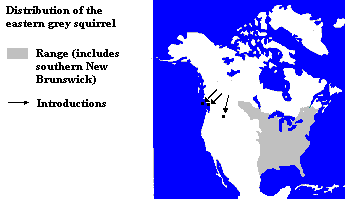
Feeding
The eastern grey squirrel is an opportunist when it comes to finding food and can therefore live in a wide variety of habitats. Its diet varies with the seasons, depending on what is available at the time. In early spring the buds of several types of hardwood trees, in particular the maple, are its staple diet. During the summer, the winged seeds of maple (samaras) and elm seeds are the major items in the diet, together with a wide variety of berries and other wild fruits, seeds, nuts, and apples. In the autumn hard nuts, including acorns, hickory nuts, butternuts, walnuts, beechnuts, and pine seeds, are their most important foods. The squirrels become industrious hoarders at this time of year, burying hundreds of nuts and seeds for the winter, when other foods are relatively scarce. If a nut crop fails, the following winter can be a very difficult time for the squirrel.
Contrary to popular myth, squirrels do not find buried nuts by memory but by their highly developed sense of smell. Not all hidden nuts will be found though; some will germinate and grow into new trees. The eastern grey squirrel often takes advantage of bird feeders as a food source in the winter. Squirrels also eat insects, caterpillars, and an occasional nest of birds’ eggs or young birds. Individuals consume 400 to 900 g of food a week.
Breeding
The eastern grey squirrel has two breeding seasons each year, the first in January and February and the second in June and July. Each of the mating periods lasts for about three weeks. Generally, only females over two years of age will breed in both seasons. Courtship behaviour begins when a receptive female begins to call continuously from a tree top with characteristic duck-like calls. Several males soon gather and some fighting may ensue to determine which is the dominant animal. As they congregate, the female becomes agitated and begins to race through the trees followed closely by all the males. When she is ready she will stop and allow the dominant male to mate with her. The male then has no further role in bringing up the young.
Gestation, or pregnancy, takes 40 to 44 days. An average of three young are born, although the litter size may range from one to six. Litters in summer are usually larger than those of late winter. The female generally gives birth in a warm, sheltered nest that she has prepared in a cavity inside a hollow tree. Sometimes leaf nests are used, especially for a summer litter if a tree den is not available. Although the squirrel prefers to build its nest in a cavity inside a tree, it is often forced to resort to a leaf nest because of the scarcity of suitable tree dens and the unhealthy conditions of these dens after they have been lived in for several months.
Leaf nests are most often built near the tops of large pine, hemlock, maple, birch, and oak trees, where they are lodged in a large crotch or on a limb near the trunk. A platform of twigs forms the base of the nest proper and an outer shell of leaves and twigs makes up the conspicuous outside part of the nest. In most nests an inner shell is also made, consisting of the same material as the outer shell but more closely woven for stability. Mosses, grasses, and shredded bark line the inner chamber and sometimes cloth, paper, vegetation, and bird feathers are also used.
The newborn young are naked and blind and weigh about 15 g. They mature quickly, developing hair by three weeks; at four weeks the tail is well furred. Their ears open by four weeks and the eyes a week later. By eight weeks the young squirrels are venturing out of the nest for short distances. Weaning, or making the transition from the mother’s milk to other food, begins at this time and at about 12 weeks the youngsters will be almost adult size and quite independent of their mother. The males reach sexual maturity at 15 to 18 months and the females at 11 months. The average lifespan is normally less than six years, although some wild eastern grey squirrels have been found to be as old as 13 years. Captive squirrels have lived for 15 to 20 years.
Conservation
The eastern grey squirrel has many mammalian enemies, including mink, weasel, red fox, fisher, lynx, bobcat, and wolf. Young squirrels in the nest are vulnerable to raccoons, snakes, and red squirrels. Numerous myths suggest that the red and the grey squirrels are bitter enemies and that the red will castrate the grey at every opportunity. In reality the even-tempered grey squirrel usually gives way to the more aggressive red in a confrontation, avoiding a fight.
The most dangerous bird predators of the grey squirrel are Northern Goshawks, Red-tailed Hawks, Cooper’s Hawks and occasionally Broad-winged Hawks. Grey squirrels occasionally fall prey to Great Horned Owls or Barred Owls. This danger is limited, however, because owls are nocturnal hunters whereas squirrels are most active in the daytime. Northern pike and walleye have also been known to take grey squirrels that were swimming across streams or lakes. In cities, dogs and cats take their toll, although adult squirrels are usually too agile to be caught. In some areas the greatest enemy of the eastern grey squirrel is probably people, who regard it as an important small game species. People have also cleared great tracts of hardwood forest, severely reducing the natural habitat of the squirrel and thus its population. Large numbers of squirrels are killed every year by cars.
The failure of a vital food source can lead to either starvation or a general weakening of the squirrel population, making it vulnerable to diseases and pests. Parasites have a harmful effect on the health and productivity of the eastern grey squirrel. The worst insect pest is the botfly larva. Scabies, or mange, leaves squirrels with patches of bare skin. In the resulting weakened condition, they often succumb to cold or infections, or become easy prey for predators. Other pests that parasitize eastern grey squirrels are ticks, fleas, lice, and round and tape worms.
The economic importance of eastern grey squirrels is limited. Their pelts currently have little value, although the tails can be used for fishing lures. Squirrel pie is considered a delicacy in parts of the United States but is not a staple food. Hunters have to be quick and accurate to shoot the swift and elusive eastern grey squirrel. It is interesting to note that naturalist Ernest Thompson Seton credited these qualities of marksmanship, developed to a high degree by early American squirrel hunters, with helping to defeat the British during the American revolution.
Eastern grey squirrels do not cause significant damage to agricultural crops and indeed are important agents of reforestation. Their habit of burying nuts, many of which are forgotten and later germinate, helps to re-establish the hardwood forests that have been severely reduced by human harvesting.
Grey squirrels can become a nuisance when they invade an attic, cause damage around the house, dig up bulbs in gardens or drive birds away from feeders. This is surely offset, however, by the pleasure they give to numerous city dwellers, campers, and everyone who enjoys the outdoors.
Resources
Online Resources
CWF, Coming to Terms with Squirrels
Natural History Notebooks, Eastern Grey Squirrel
Fletcher Wildlife Garden, Eastern Grey Squirrel
Print resources
Banfield, A.W.F. 1974. The mammals of Canada. University of Toronto Press, Toronto.
MacClintock, D. 1970. Squirrels of North America. A California Academy of Sciences Book. Van Nostrand Reinhold Co.
Seton, Ernest Thompson. 1928. Lives of game animals: Gray squirrel. Volume 4. Doubleday, Doran and Co., Inc., Garden City, New York.
Woods, S.E., 1980. Squirrels of Canada. National Museum of Natural Sciences, Ottawa.
© Her Majesty the Queen in Right of Canada, represented by the Minister of the Environment, 1983, 1990. All rights reserved.
Catalogue number CW69-4/67-1990E
ISBN 0-660-13634-1
Text: Heather Hamilton
Revision: D. Smith, 1990
Photo: Tony Beck



